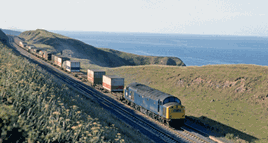The rearrangement of BR into business sectors in the late 1980s brought Freightliner under the control of Railfreight Distribution (RfD), the non-bulk arm of the BR freight business. Operationally, most Freightliner trains continued to run separately from other freight flows - the only route where Freightliner regularly shared haulage with other RfD traffic was between Bristol and Coatbridge, where two Freightliner flats were attached to scheduled Speedlink services.
Under RfD management specific traction pools were allocated to Freightliner traffic for the first time. In May 1988 the Freightliner stock list comprised ten Class 08 shunters, three Class 31 diesels, 27 Class 37 diesels and 29 Class 47 diesels, together with 26 assorted AC electrics (mainly Class 86, but also including some examples of Classes 81, ‘85’, ‘87’ and ‘90’). Gradually the fleet would become more standardised, with the Class 31s and older electrics phased out.
In 1989 Freightliner’s poorly-sited Stockton depot was replaced by a new terminal at Wilton, financed partly by a European grant. Wilton was located within ICI’s Teesside complex - this was useful not only because ICI was Freightliner’s biggest customer in the region, but also because containers could be transported between the rail terminal and local ICI installations without using public roads, which were then subject to a 38-tonne weight restriction.
At the start of the 1990s Freightliner faced an uncertain future, as plans were laid for railway privatisation. Two particular challenges loomed: the first was the need to replace the Freightliner wagon fleet, which was nearing the end of its useful life; the second was to accommodate the growing number of 8ft 6in and 9ft high containers that were landing at Britain’s deep-sea ports.
The wagon supply issue was alleviated when BR ordered 700 new intermodal flats from Arbel Fauvet, with the first deliveries in 1991. The new wagons were semi-permanently coupled in two- and three-wagon sets, which gave the operator greater flexibility compared with the five-wagon sets of first-generation stock. Freightliner also started hiring single flat wagons from Tiphook. These were particularly useful for carrying Freightliner traffic on non-Freightliner routes, such as paper from Corpach and aluminium from Fort William.
While the new standard flats and the Tiphook hire-ins could carry 8ft 6in containers on key routes such as the West Coast Main Line, other solutions had to be found for conveying 9ft containers on those routes and for conveying 8ft 6in boxes on more heavily restricted routes.
During 1990 rakes of ‘Multifret’ wagons hired from the French operator SNCF were trialled. As well as providing a lower deck for high containers, the ‘Multifrets’ were designed for 90mph operation, compared with the normal 75mph maximum speed of Freightliner trains.
A longer-lasting solution for carrying taller containers was the fleet of 45 ‘Lowliner’ wagons that entered service with Freightliner in summer 1991. With their deck height of just 720mm above rail level, compared with 980mm for a standard second-generation wagon, the ‘Lowliners’ could carry 9ft 6in boxes on those routes cleared for 8ft 6in containers on conventional wagons.
However, in their early years the main role of the ‘Lowliners’ was to carry 8ft 6in containers within the tight clearances of former South Eastern & Chatham Railway lines in north Kent, a job that became necessary when Freightliner began serving the new deep-water container port of Thamesport. A temporary railhead was provided at Thamesport in 1991, followed by a permanent facility in March 1993.
In the Irish market, Freightliner’s 23-year association with the North Wales Coast Line ended in March 1991, when Sealink withdrew its freight sailings from Holyhead to Dublin and Belfast. Initially all Irish Freightliner traffic was diverted to run via Ellesmere Port, using the former Cawoods railhead on the docks branch. It was later switched to Seaforth, until volumes shrank so much that Freightliner withdrew from the market.
As railway privatisation drew closer, BR subjected the Freightliner network to a detailed review in an effort to improve Freightliner’s financial performance. The RfD division, of which Freightliner was a part, was regarded as the weak link in the BR portfolio, even after the closure of the heavily loss-making Speedlink wagonload network in July 1991. Freightliner itself was an unattractive proposition to potential buyers.
The review resulted in a revamped timetable from May 1992, followed by some fine-tuning in January and May 1993. Freightliner reduced the number of direct trains between terminals, and gave Crewe Basford Hall yard an enhanced role as a portion exchange point for deep-sea traffic. Daily services operated between Crewe and all UK Freightliner terminals, so that almost any itinerary was possible with just one change of train. This change led to more efficient locomotive diagramming, with fewer examples of diesel traction running long distances under the wires.
Those parts of the Freightliner network that catered for non-maritime traffic came under increasing pressure as domestic traffic volumes dropped. The two main London terminals were vulnerable because the city was too close to the deep-sea ports for the use of rail to be viable.














Login to comment
Comments
Mike Townsend - 24/08/2017 15:32
Mike townsend, am looking for any photos of the former York way freightliner depot whilst electrified at 25kv
Mike Townsend - 07/02/2018 14:18
Are there any photos of class AL6 /86 Locomotives at York way freightliner depot between 1967/71
Dave Waugh - 28/03/2020 11:21
I am running out of hope finding any MAT container trains. Found loads of MAT cartics but they did run a container service from Cowley/Oxford to Harwich, Parkston quay for British Leyland KDP onward to Belgium. Any help would be much appreciated.
Collins - 28/03/2021 07:52
Nice n information
Eric Thelan - 05/12/2022 21:47
Was the York Way dedopt the former LNWR Maiden Lane deopt? Did trains acess the ECML via the North London Incline?
Mike Townsend - 04/02/2024 16:19
Are there any photos of York Way freightliner depot (Maiden Lane) 1965 to 1971